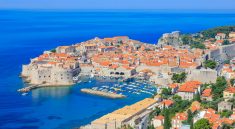However, there’s a ton more to Croatia than meets the eye, so it is well worth planning several detours to consider in a few of the nation’s contemporary structure, offbeat attractions and unexpected cultural relations.
To get a voyage to the tumescent recesses of the human mind, you will find several better starting points compared to Zagreb’s Museum of Broken Relationships — a travelling art installation which turned into a permanently grounded museum in 2010. According to mementoes given by the general public, it is a compelling and one of a kind tradition of wistful memory and raw emotion, with displays which range from garden gnomes to prosthetic limbs. Each is accompanied by a text describing why it was significant for the donor — a few are touchingothers very kinky; and a few belong into the obsessive world of a David Lynch film.
Adriatic Modernism: remain in the Hotel Lone
Through the 1960s and 70s that the Adriatic shore experienced a boom in modern architecture, and there are indications which Croatia’s modernist customs are making a comeback. Looming out of the trees over Lone Bay, just outside the posh Istrian hotel of Rovinj, the amoeba-shaped Resort Lone was created by Zagreb architects 3LHD, also full of furnishings, fabrics and artworks provided by Croatia’s top creatives. Finished in 2011, it is a rare instance of a fresh Adriatic resort that serves as both luxury lodging and total work of art. If you can not afford a space, peek in the round reception to watch Ivana Franke’s geometric installment Space for Running Ghosts, or the fabric wall-hangings knocked up by Zagreb style designers I-GLE.
The discovery of Neanderthal bones around Krapina in 1899 places this tiny north-Croatian town firmly in the European prehistory map. But it required until 2010 to get Krapina to find the memorial it deserved — an ambitious, ultra-modern, hillside-hugging architecture that’s little short of a tradition of existence, the universe and everything. Visitors ascend a spiral pathway, facing phases in the planet’s growth from large bangs onwards. And as a tour de force in literary theory, the memorial appears ensured to ship creationists squealing for the leaves. The most interesting areas of the museum are dedicated to the Neanderthals themselves – a movie featuring human celebrities in prosthetic masks re-creates per day in the life span of a Neanderthal tribe, along with the screen culminates at a diorama featuring startlingly lifelike Neanderthal dummies.
Few European cemeteries are as relaxed and meditative as the town graveyard at Varaždin, a small horticultural masterpiece which was really much the lifetime’s work of playground Hermann Haller (1875-1953). A serious student of European graveyards, Haller arrived at the conclusion that cemeteries must be life-enhancing public parks, in place of the sombre preserve of wreath-laying mourners. He planted row upon row of conifers, carefully sculpted into stately green columns that towered on the graves themselves thereby supplying”silent and harmonious hiding places” to the dead person, as Haller himself clarified. It is also something of an outside art gallery also, using an abundance of fine funerary sculpture in one of the greenery.
The medieval suits the contemporary: Novigrad Lapidarium
When there was a league table for excellent tiny museums of the world afterward Novigrad’s Lapidarium would certainly wind up someplace in the top ten. Developed by Rijeka-based architects Randić and Turato, the advanced construction includes two black-box display spaces enclosed inside a glass pavilion. The displays feature some fantastic illustrations of rock carving taken from Novigrad’s ancient churches. Animated gryphons, strutting peacocks and swooning cypresses exemplify the excitement for attractiveness in ancient Croatian art.
Head to the Joker shopping center, northeast of fundamental Split, and you’re going to come face to face with a bolero-wearing bronze sculpture of Hollywood director Orson Welles. Croatia became a second home to Welles, that acted at local-made movies (like the partisan war epic Battle about the Neretva at 1969), had a vacation villa in Primošten, also — based on local lore — was a fervent director of Hajduk Split soccer team.
Twenty-first century townscapes: The Sea program and Allergic into the Sun
This wave-powered musical tool, which also functions as vantage point from which to watch the sunset, will probably lull you into a country of Adriatic bliss. Situated on the seafront promenade in Zadar the manhood is made up of wide rock stairway descending towards the ocean. Wave activity pushes air through a collection of submerged pipes and upward through niches cut to the measures, making a choice of tender musical notes. The organ’s architect, Nikola Bašić, also made the Greeting into the Sun simply up the seafront — a massive disc wrapped with light-sensitive tiles, which collect solar electricity throughout the daylight and radiate a seemingly arbitrary string of colored lights during the night. It is absolutely hypnotic and hugely popular with tourists of all ages, who will spend hours basking in the Greeting’s mood-enhancing shine.
It had been the 19th-century naval metres of Rijeka that gave birth to the world’s first torpedo, constructed for its Austro-Hungarian navy by celebrated Croatian engineer Ivan Blaž Lupis along with his English colleague Robert Whitehead. To observe a living example nonetheless, you need to visit Split, in which an incredibly anonymous corner of this Maritime Museum plays host to among Croatian technology’s greatest triumphs. Looking like something from a Jules Verne book, this slick cigar-shaped relic owns an undeniably seductive atmosphere.
Express a fascination with vampires in the Croatia and you’re probably going to be told that you have come to the wrong nation — and belief in the supernatural critters was prevalent here before a few centuries past. Europe’s first recorded case of vampirism happened in the Istrian village of Kringa at the 1670s, once the nocturnal bed-hopping experiences of recently-deceased Jure Grando (along with the following stake-through-the-heart actions taken by natives ) was captured for posterity by Slovenian chronicler J.J. Valvasor. Surprisingly, little was made of the vampire legacy up to now, save for a little Jure Grando museum at the middle of Kringa; the next-door Caffe-Bar Vampir is much more welcoming than it seems.
For an open source concert experience with a gap, go 3km east of Dubrovnik to locate Orsula Park, a radically sloping region of footprints and pathways controlling a famously jaw-dropping perspective of the walled town and its interface. The park’s amphitheatre-style bank of seats is pushed into use every summer throughout the Mali Glazbeni Festival (Little Music Festival), a year of festivals that attracts lots of the large regional names in rock, rap and world music. Live gigs beneath the stars do not come much better than this.





